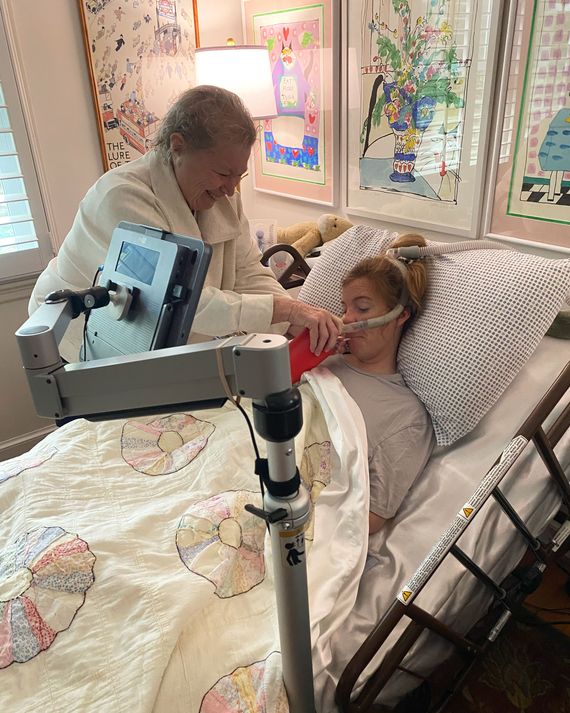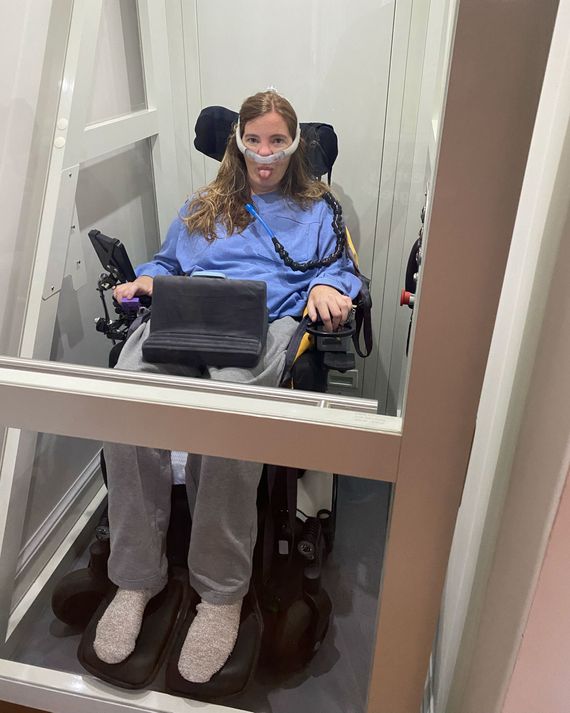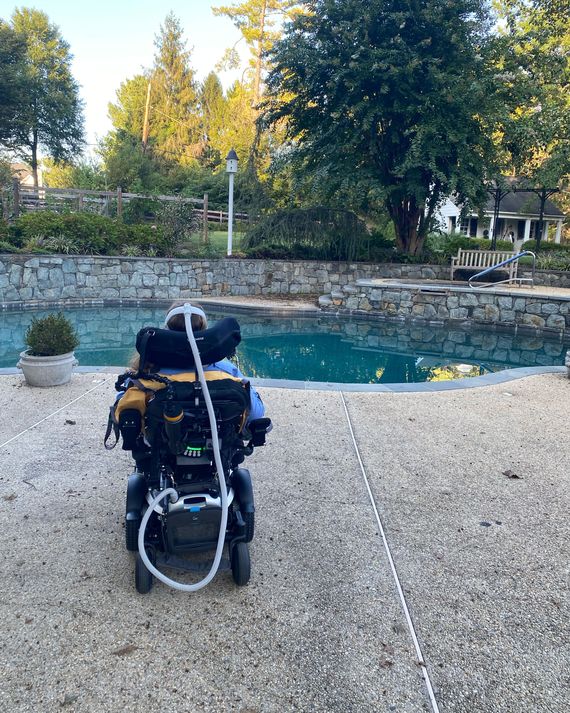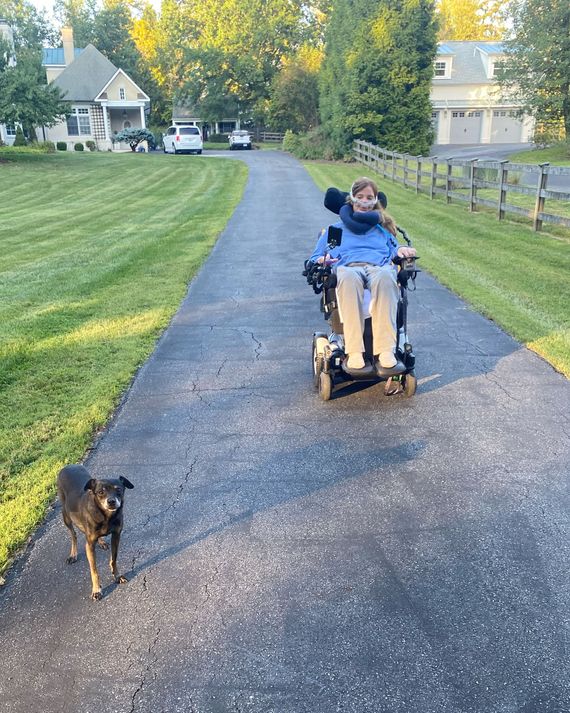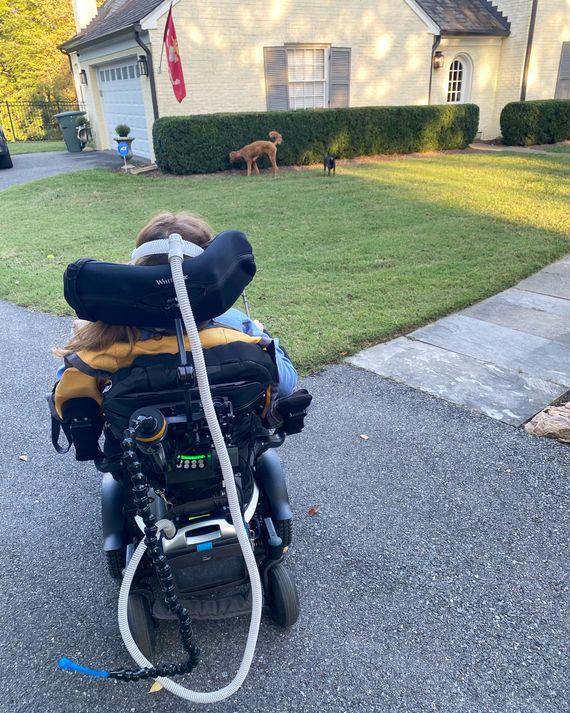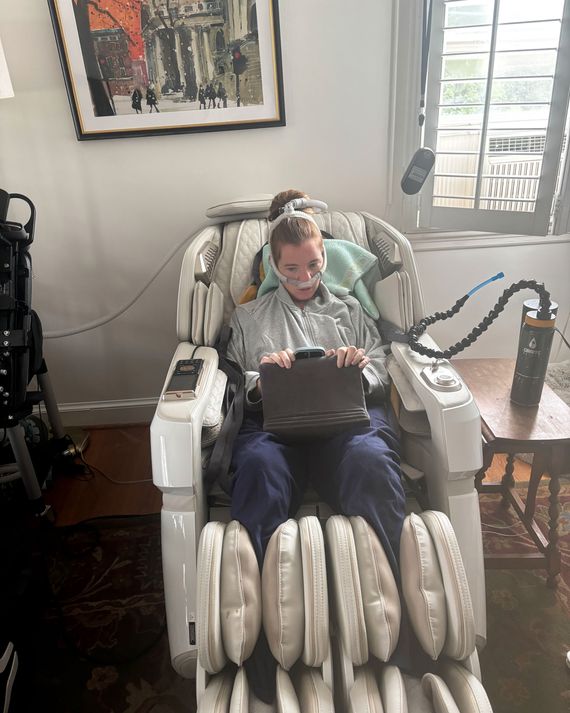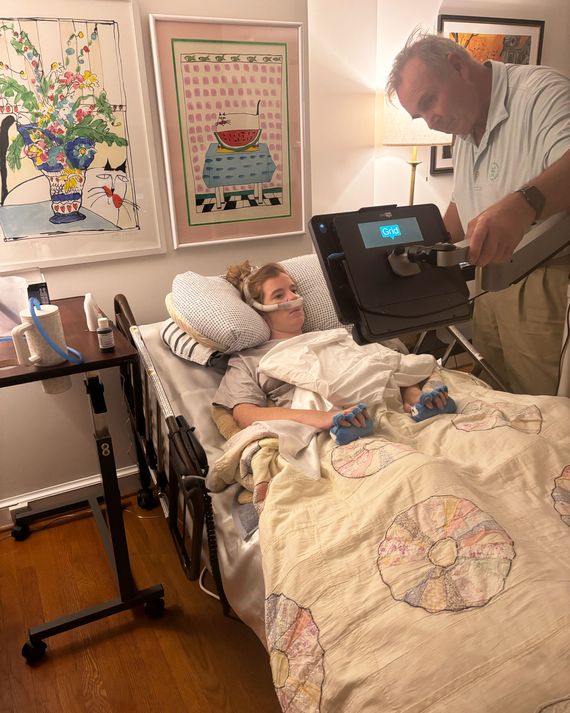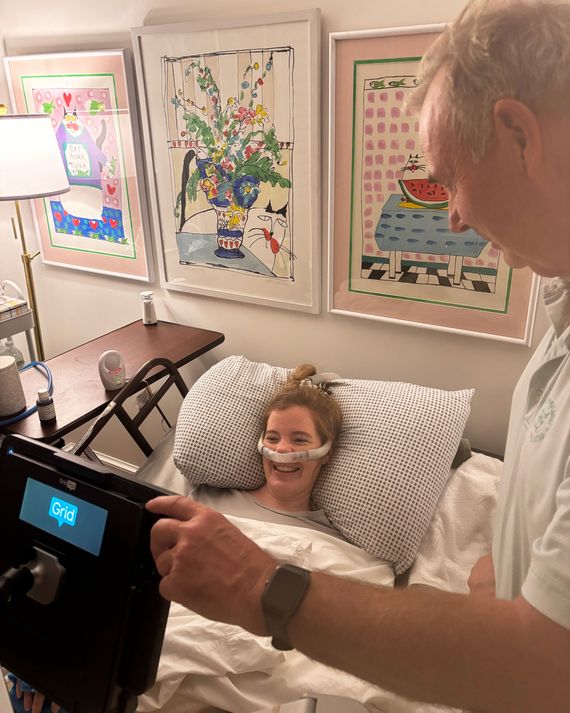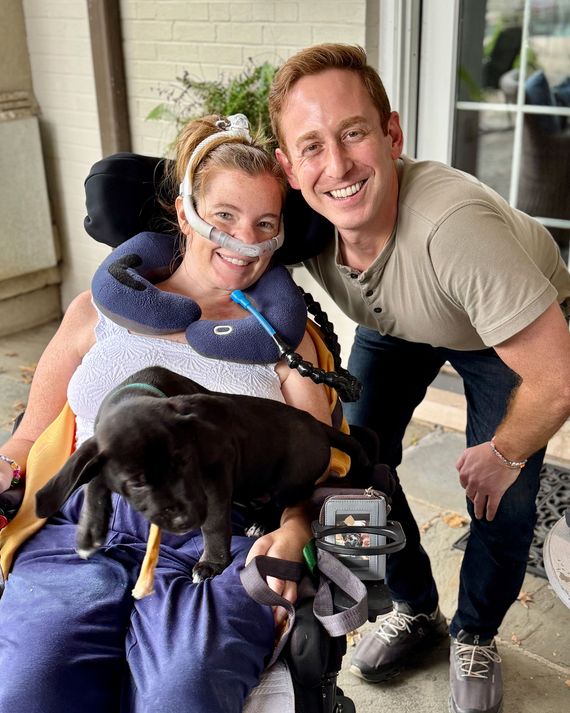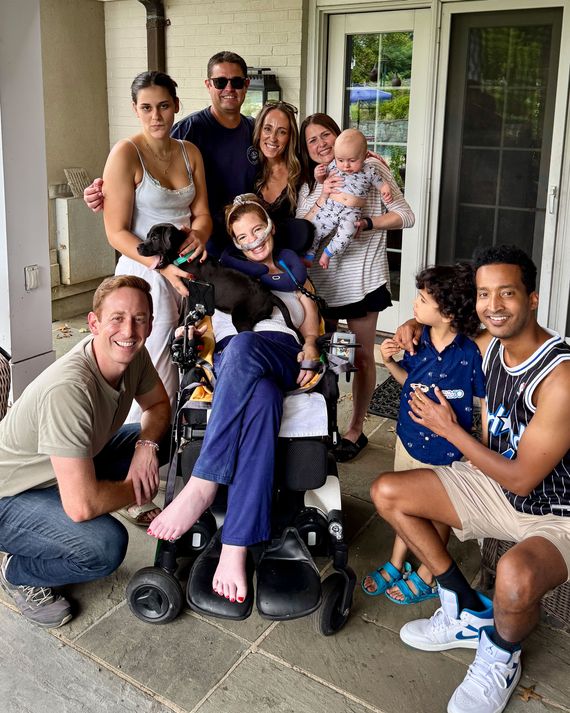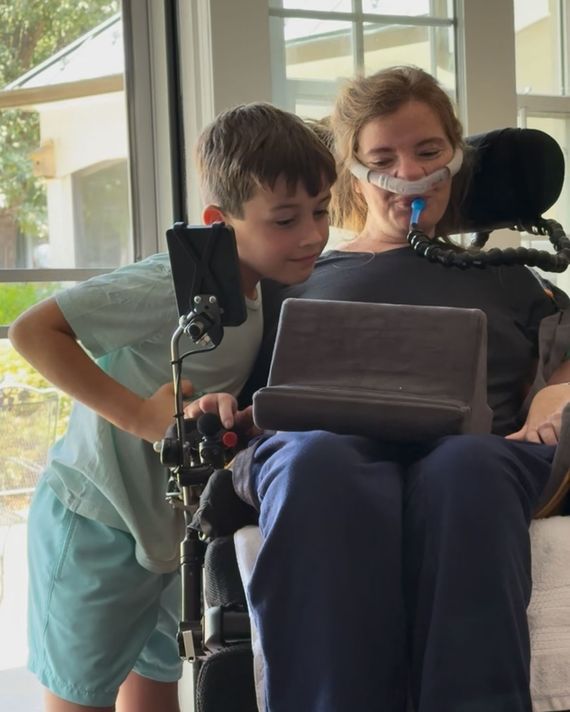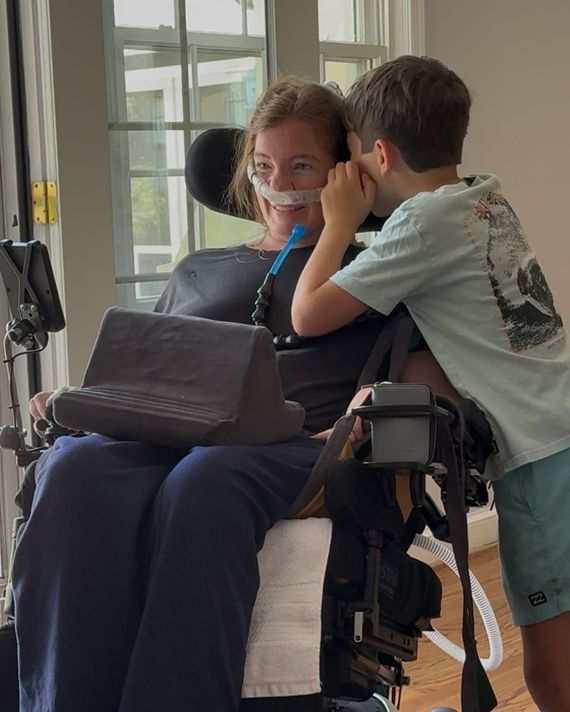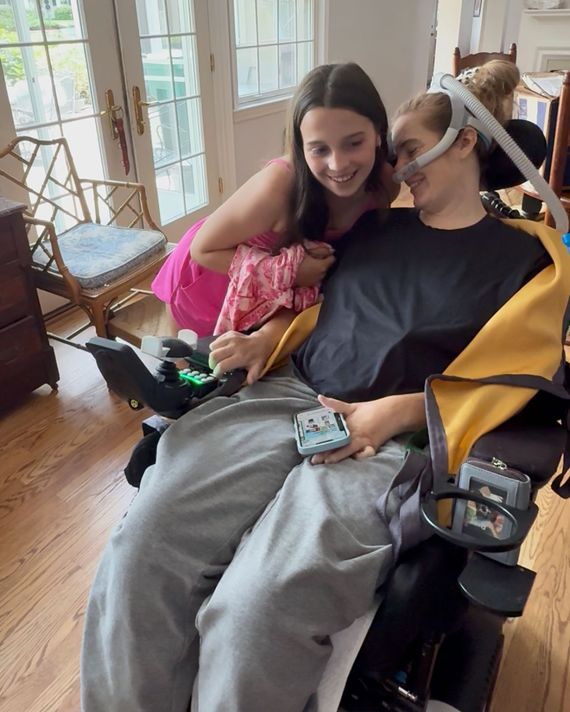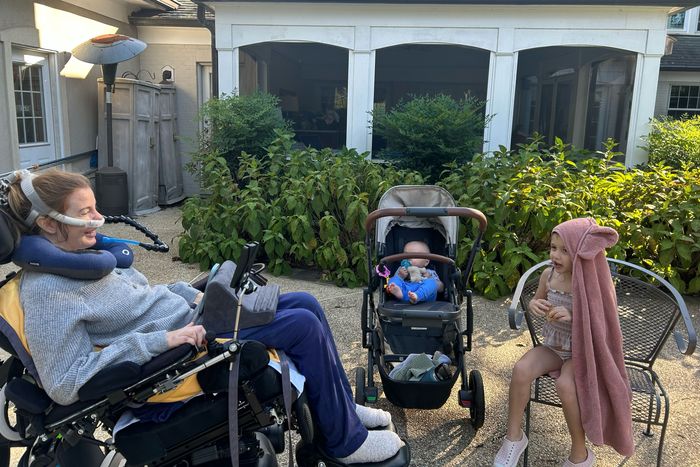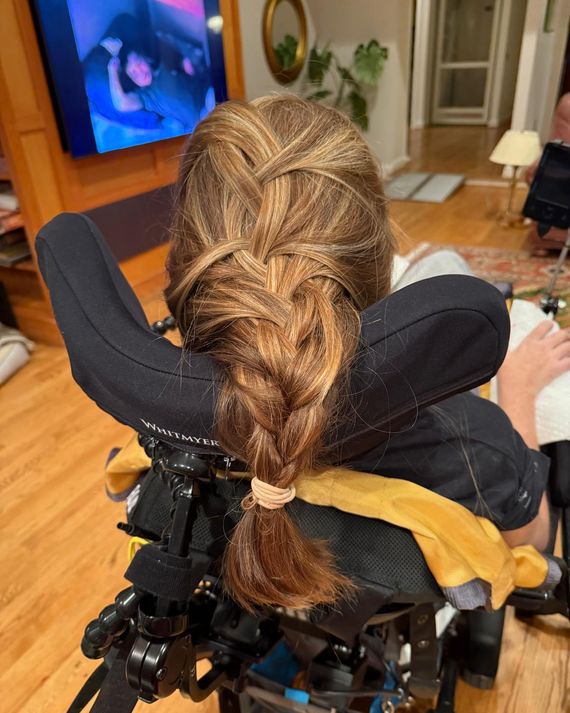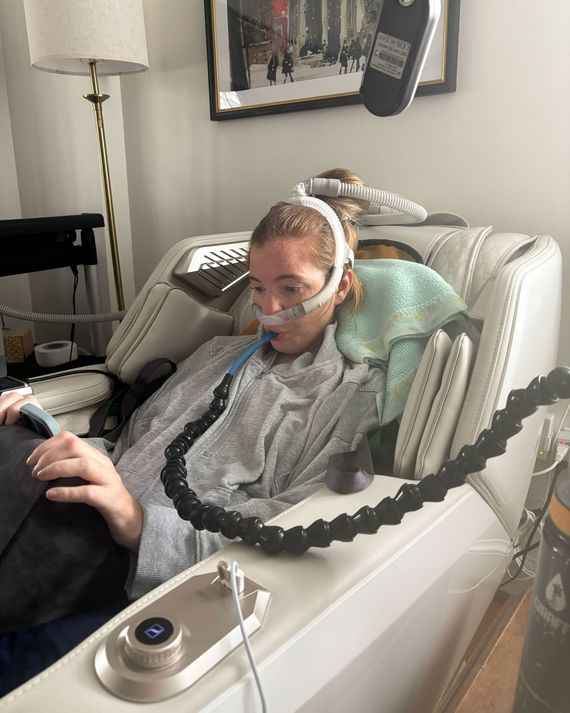
Photo: Courtesy of Brooke Eby
In the past three years, Brooke Eby has gone from Peloton classes to a walker to a wheelchair. In her late 20s, Eby, now 36, noticed a tightness in her left calf that she didn’t understand. The following year, while walking with her Salesforce colleagues in New York City, she couldn’t keep up. She later started limping, unable to lift the front part of her left foot, a symptom called footdrop, which led her to countless appointments with various specialists and doctors.
“I don’t like what I’m seeing,” a neurologist said to Eby in March 2022, four years after she started searching for an answer. The doctor observed her symptoms’ expansion to her right leg and also twitching in one arm. Finally, at 33, Eby was diagnosed with amyotrophic lateral sclerosis, also known as Lou Gehrig’s disease. ALS is a neurodegenerative terminal illness in which the brain stops sending signals to the muscles, atrophying until the person dies. After Eby’s diagnosis, as she often describes it, she spent the next couple months in bed, devastated and “pounding M&Ms.” “Those first couple months … I didn’t even want to pick up the phone,” she tells me over Zoom. “I was like, I’m going to have to tell this person to just ruin their day.” She dreaded attending the wedding of a college friend two months after her diagnosis in May where she’d be a bridesmaid. She didn’t cancel though — instead, she fell back on humor.
It “was probably the first time I had people laughing about a mobility aid,” Eby says, who relied on a walker. “Once we started dancing … and having fun and people started responding and laughing, I was like, Oh okay. I could still be myself.” In the following months, Eby compiled lists of all the funny things people had said since her diagnosis. She posted her first video about her ALS to TikTok two months later, followed by a video from that May wedding. In it, her friend is riding on her walker on the dance floor and the bride is limboing under it. The rest is social-media history.
Eby has since brought over almost 600,000 followers across TikTok and Instagram, including celebrities like Lindsay Lohan, Chrissy Teigen, and Abby Elliot, into the life of a young woman living with ALS — from a TikTok of texts from potential suitors after she shared she used a cane (like “I’m good at giving piggy backs”) or a video of her using a beer bong to ingest a foul-tasting new ALS medication. “The material honestly just kept writing itself,” she says. Her story — and her content — went on to be featured on the Today show, and in People and the New York Times.
Eby’s content isn’t all jokes though, particularly this year as her health has declined rapidly. “I’m pretty far progressed at this point,” she says. Eby, who last year was named one of Time’s top 100 most influential people in health and was recently the subject of a feature in Rolling Stone, now lives with her parents, whom she moved back in with last year. Most of her body is paralyzed except for a few fingers and her face. Breathing has become more difficult for Eby. She had a feeding-tube surgery in June as “insurance.” “They were like, ‘We don’t want to put you under if it’s any worse than this.’” She’s currently connected to a breathing machine, known as a BiPAP, almost 24 hours a day. Eby paused throughout our interview to take a breath, her tone strained and softer than it was months ago and her wit faster than her ability to articulate it. Eby’s followers remain loyal, but some commenters note that her videos are increasingly hard to watch. Eby acknowledges that, but perhaps that’s the point. “I wouldn’t think people would be comprehending what’s happening to me unless they’re having that response,” she says.
Eby wanted to be a face for the disease when she started. (“Rather than what I had to picture, which was my friend’s grandpa for no reason,” she says.) Before her diagnosis, she says, she mostly connected the disease with old men. Watching a woman in her 30s with ALS hopefully will make people think, “Oh shit, this could actually happen to anyone,” she says. She’s helped fundraise over a million dollars and, last year, founded her nonprofit, ALStogether, a “Slack community for the ALS community,” she says. She also recently launched an adaptive clothing line with Silverts.
The need for Eby’s work, increased awareness and fundraising, can’t be overstated. “We don’t know why people progress at different rates or at different points of their body,” Eby says. “It’s hard to have faith that they’re going to figure anything out when it doesn’t feel like it from the patient side of things that anything has changed over the last hundred of years since Gehrig got it.” Today, there are only two approved medications for sporadic ALS (ALS that is not genetically inherited), which accounts for the majority of ALS diagnoses, including Eby’s. The available medications can only potentially expand a person’s life by months.
These days, Eby is focused on living in the present. “I’m not allowing myself to really think about what tomorrow’s going to look like,” she says. Her main goal is to spend as much time as she can with the people she loves. “I’ve slowed down quite a bit, but,” she tells me, “I guess I’ll just keep talking into my phone.”
Brooke and her mother.
Photo: Courtesy of Brooke Eby
Most mornings when my caregiver isn’t here, one of my parents will bring me coffee. Some days I wake up early, I can’t fall back asleep so I’ll sit until I hear someone awake. There is a baby monitor next to my bed that we put in a few months ago. I used to have a call button, but then my finger got too weak to press it. I freaked out thinking, What if I was choking or what if I fell and I couldn’t alert anyone? So we got these baby monitors and they’re on all the time. My parents can hear whenever I’m speaking, which is great for me, but they have to hear me listening to TikToks late at night.
My morning and bedtime routine used to take ten minutes: hop up, shower, get ready, and out the door. I now have to wake up two hours before anything I have to do. I usually wake up around 10 a.m. I’ll have coffee in bed and sometimes I’ll eat a pastry. Then we have to transfer me into the bathroom, brush my teeth, go to the bathroom, and then transfer me into either my chair or my massage chair. On the days my caregiver comes, we shower, which is a two-, maybe two-and-a-half-hour ordeal to get me in the shower, get the sling out from behind me, and shower me.
I take a lot of medicine in the morning. I think I’m on six medications, but some of them have multiple pills, so I guzzle pills in the morning and night. None of them are actually ALS specific, because there are no good drugs for ALS right now. There are two approved medications for it, but a lot of people don’t take them because they’re expected to extend your life by months and a lot of people experience side effects. I also take medication for my stomach and I’m on two different antidepressants and then birth control, so I don’t have to deal with the period every month. I’m also on baclofen and gabapentin, which are both for spasms and nerve pain and are supposed to help you sleep too.
Photo: Courtesy of Brooke Eby
In this picture, my top is from my Silverts collection and I’m going downstairs for dinner in an elevator, which kind of looks like I’m in a wide fridge. My parents say that I hibernate up in my room. I have everything that I need up here, but I go downstairs to watch football games or eat dinner with them or to go outside and sit by the pool.
When I first moved back in with my parents, I lived in the living room. Then we put in an elevator back in May so that I could move upstairs and have more space. To operate the elevator, someone has to open the door and then you have to hold the button down the whole way, but you can do that from the outside of it. So my parents can either come in with me or operate it from the outside.
Someone told me that my wheelchair costs between 30 and 100 grand. It’s like the cost of a car. They have to custom-fit it to your body. To the right of my hand is the wheelchair screen that tells you your speed and what mode you’re on, like the joystick. And then right beneath that is the actual joystick that you use to steer. My insurance covers one every five years, so I think they expect your physical needs will change after five years. But for people with ALS, it’s usually one.
On the back of my wheelchair, we have a water bottle attached with a straw that wraps around along with my breathing machine. On my lap is a little phone-holder because I can’t really hold up my phone anymore.
Photo: Courtesy of Brooke Eby
I sit out back sometimes when it’s sunny out. I mostly stare off into space and sit in the sun because I’m always cold in air-conditioned spaces. Sometimes I’ll do videos out there. Sometimes work, sometimes nothing.
On this day, I was filming the video that I posted about my latest breathing test. (Eby scored a 12 on a forced vital-capacity test, which measures how much air a person can exhale.) I’m desensitized because it never feels that emotional. When I’m making the video, it’s pretty cut and dry, but then once I hit post, I start seeing the comments come in and I’m like, Oh boy, I freaked everyone out today.
In a prior appointment, my score dropped from 75 down to 27, which was the big drop. I wasn’t crying, but it felt like a dark cloud over me emotionally. Once I hit 27, I knew after that it wasn’t going to get any better. So going 27 to 12, to me, I was like, Big whoop. I honestly didn’t even care. At both of those numbers, I was having to wear this machine all the time anyway, so what’s the difference?
Photo: Courtesy of Brooke Eby
Dray, short for Draymond (after the Warriors’ Draymond Green), is the dog that I rescued when I was 25 and living in San Francisco. It’ll be our ten-year adoption anniversary this December. We’re now both falling apart at the same rate. In the last three years: He’s diabetic, has pancreatitis, and limps all the time.
This walk is his big outing of the week. We do it once a week. We have to be a little more gentle on his body, so we don’t go very far.
Photo: Courtesy of Brooke Eby
Two doors down there’s another dog, his bestie in the neighborhood, named Brownie that’s always sitting in his front yard. Brownie can go inside, but he just doesn’t want to. He sits in the front lawn waiting for visitors. The two dogs play for about 30 seconds.
Photo: Courtesy of Brooke Eby
The only two places I could sit before were my wheelchair or the bed, so we got this massage chair. I wasn’t getting a ton of stretching or range of motion exercises, so my parents started looking into massage chairs that could move me around. We found this one that can cycle your legs like a bike. It was supposed to be for me, but both my parents ended up liking it too. The movement helps, but most of the time I have it on a normal massage setting just to get my blood circulating.
I can’t move anything, but I can feel everything. My sister, who is a doctor, explained it to me, and I’m probably going to botch this, but, there’s two different kinds of neurons. One is a motor neuron that helps you move, and then the other is a sensory neuron that makes you feel. With ALS, it’s just the motor neurons that die off. I still feel everything, which is kind of rude. Honestly, when you can’t move something and you get stuck in a position, it’s very painful.
My dad is an engineer and my mom’s kind of a bulldog, so between the two of them, if they see a problem, they do their own research. The resources that are given to people with ALS are fairly basic. There are resources, but they’re not bountiful, is the best way to describe it.
I’m not that relatable in the sense that financially I’m pretty comfortable. For a lot of people with ALS, it’s tough. Unless you have money, you’re going to die faster or you’re going to be very uncomfortable.
Photo: Courtesy of Brooke Eby
I’m reading in my massage chair. Sometimes, I’ll take work calls like this. I just started Atmosphere by Taylor Jenkins Reid. I only heard of it because Goodreads recommended it every day in my email so I was like, Okay, fine.
I’ve become a big reader since being diagnosed. At the beginning I was almost manically reading to take my mind off stuff and then I kept up the habit. It takes me a while to fall asleep at night or I’ll wake up in the middle of the night and I can’t fall back asleep so I’ll just read nonstop. I usually read fiction, but a lot of psychological thrillers.
Brooke and her father.
Photo: Courtesy of Brooke Eby
For bedtime, I take my medicine, brush my teeth, we transfer me from my chair to the bathroom, then transfer me from the bathroom to the bed. Getting me comfortable in bed is a solid 30-minute process because once I get in, I know I’m going to be in that same position for 12 hours, which is claustrophobic to think about. So I’m always like, “Half an inch to the left” and then “Nope, go back quarter of an inch.”
Under my pillow, there are towels on both sides. If my head rolls to the side, it can get stuck, so we have to put barriers to prevent that. The little blue things on my hands are trying to keep my fingers somewhat straight. I have pillows and towels under my elbows so that they don’t ache. My bed has 30 towels on it at any point in time.
Here, my dad is setting up my eye gaze for me, which is his area of expertise. Most people know the eye gaze as a tool to communicate. It calibrates with your eyes and then you’re able to type and text just using your eyes. A lot of people who lose their voice will use the eye gaze to communicate. They’ll type with their eyes and then the device will speak for them and you can put in your own voice so that it sounds like you coming out.
You have to calibrate it every time you turn it on. So my dad will put it in one spot, there’s a little green space basically that looks back at me that you have to line up exactly, and then calibrate it. It throws a dot all around the screen that you look at with your eyes, and then for the most part, it gets where your eyes are and then works from there.
He’s putting it at the right angle so that I could read my book before bed. For me, since I’m still talking, the main things I use it for are reading my books, scrolling TikTok and Instagram, and looking at my email. It’s just a computer basically and the mouse is my eyeballs.
I usually get in bed by 11 p.m., but I don’t go to sleep until probably 1 a.m. The time in bed right before you go to sleep is the time when no one’s asking anything of you and so you just want to maximize that time as much as you can. People call it doomscrolling, but I feel like it’s happy scrolling. I’m like, What’s doomful about this? This is the best part of the day.
Photo: Courtesy of Brooke Eby
I was trying to get my dad to move something like a centimeter. I have to control every little thing that I can. My parents like to laugh and they’re like, “Oh my God, there’s no difference.” They call me “princess and the pea” because I’m always readjusting.
This is the room that I lived in throughout high school and then we put in a hospital bed. It’s kind of strange to be back here in my 30s. One of my parents is always here in case I need something, but it’s not a natural feeling to be living at home when you’re 36 and used to living by yourself.
For the most part we get along. The moments we drive each other crazy are when I’m needing them to do something that I wish I could do myself like move the cover and itch. I can’t even do that and I lose my mind.
Brooke and Chris.
Photo: Courtesy of Brooke Eby
This is one of my best friends, Chris. We grew up together in Potomac, Maryland. We went to elementary school all the way up to high school and now we’re both townies.
He has two corgis that are very famous with millions of social-media followers. He was one of the people who encouraged me once I made the first couple of videos. He was like, “You got to keep going. People are going to be interested.” I still go to him for advice.
Most people’s houses are not accessible to me. It’s very rare unless someone lives in a condo or an apartment. I would say 99.9 percent of houses have a step that I just can’t get into so I force them all to come to me.
On this day, I had a bunch of people over in my backyard, which is our summer, regular-weekend shindig. I have people over and we sit in the backyard and just hang by the pool.
I’m wearing a neck pillow to try to just prevent my head from falling over in the first place. A lot of the neck braces are really big and hard and uncomfortable, so I just got an airplane pillow and it doesn’t work as well, but it’s a lot more comfortable.
Photo: Courtesy of Brooke Eby
A bunch of my friends from growing up have kids now, so they’ll bring the kids over to swim. Growing up, we would have pool parties here every weekend and I would be part of it. I’d be in the pool with everyone and now I continue to have those parties. I just love having people over. But now I feel like a lot of us are much more observers of the kids. It’s like watching the next generation where all the kids are in the pool and all the adults are sitting by the side. It’s crazy.
On this day. We got all these beads to make bracelets for the ALS walk. The kids were knocking over the beads for the most part.
My friends have all leaned in a lot. They come over on the weekends or they’re always texting, checking in, and calling. Even the first year I was diagnosed, they did the ALS Association’s Walk to Defeat ALS. I didn’t really want to make a big deal of it. I didn’t want people to feel like they had to come and fundraise, but my friends found out about the walk and they said, “No, we’re doing it.” Now we’re in our fourth year.
The first time the little boy who was looking at me in the picture saw me in a wheelchair, he asked, ”Why aren’t you moving? Why are you sitting all the time?” Then he saw my breathing machine and said “What’s on your face?” With adults we’re always a little more cautious of offending someone or making things uncomfortable, so we don’t ask questions. We pretend like nothing’s different. Kids crack me up because they’re so genuine and then when you answer their question, they’re like “Okay,” and walk away.
Brooke and her nephew Spencer.
Photo: Courtesy of Brooke Eby
My brother and his family live in New Jersey, but they drive down sometimes just for the day to visit and they’ll bring their two kids: Spencer, who is in this picture, and his sister, Charlotte. In this picture, Spencer was using my phone’s voice command to argue with ChatGPT. They were having an insult battle. I just sat there, watching helplessly. I couldn’t get my phone back.
At this point, my nieces and nephew are so used to me that the only thing they like to pretend is that they don’t remember that I can feel everything. They’ll pinch my legs and say, “You can’t feel it anyway, right?” They just think it’s so funny.
Photo: Courtesy of Brooke Eby
Spencer’s mom, my sister-in-law, told him that in one minute, he could say all the bad words and whisper them into my ear. He knows every bad word you could imagine! Everyone else was standing around and couldn’t hear anything. He’s not allowed to say it to anyone but me, so it’s an honor.
Brooke and her niece Charlotte.
Photo: Courtesy of Brooke Eby
I bought Charlotte overpriced PJs from Pink Palm Puff for her birthday. She had just opened them and was really excited and hugging me. She’s into what they call “preppy,” which is not what our generation thought of as preppy. It’s not polos; it’s just cute pink stuff.
Photo: Courtesy of Brooke Eby
Those are my best friend Jackie’s two kids. The older one is Emmy, who is 6 years old, and then the boy, Preston, is 6 months. They were hanging out in my backyard with me, eating candy.
Photo: Brooke Eby.
Charlotte’s working on her French braiding and did my hair. These kids grew up on YouTube. They already know how to do hair. I’m like, “You’re never going to go through an awkward phase.” She did a pretty good job and she was disappointed in it. That’s better than I could have ever done, even as an adult!
We also were watching home videos. My niece and nephew really like to watch videos of when their parents were little, so we just had those on so they could laugh at us.
